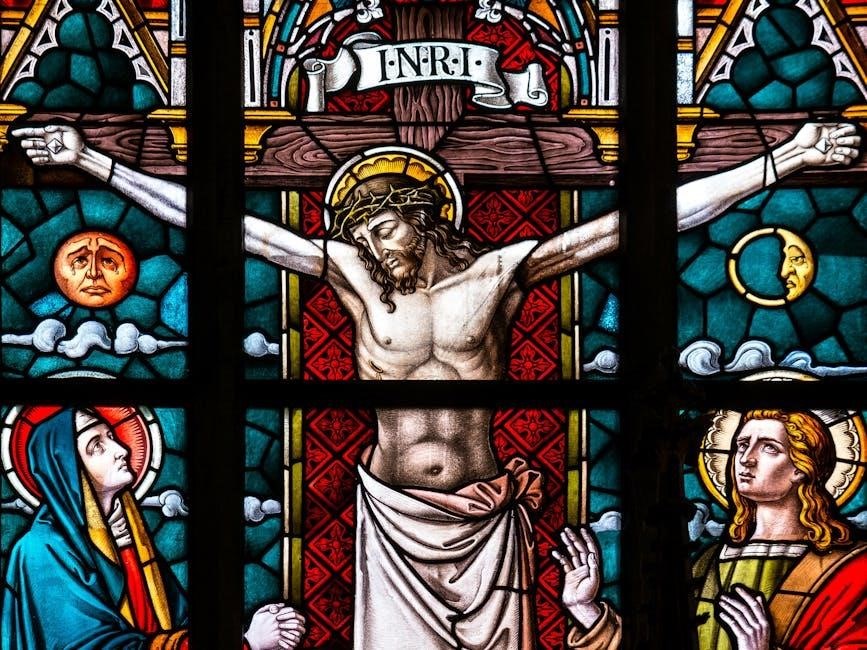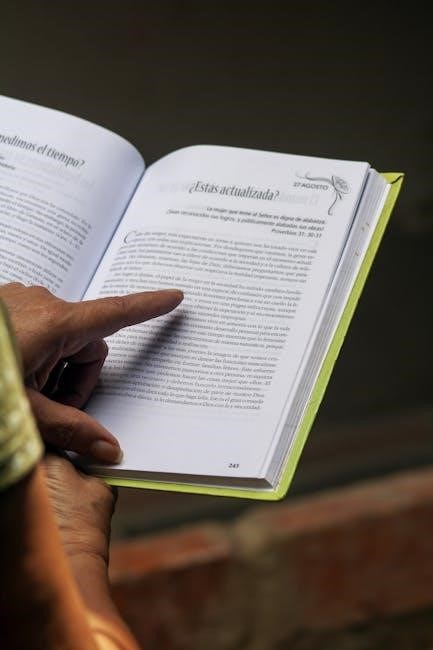The Latin Vulgate Bible PDF is a digital version of St. Jerome’s seminal translation, offering a reliable and accessible resource for scholarly and devotional use.
1.1 Historical Significance of the Latin Vulgate Bible
The Latin Vulgate Bible, translated by St. Jerome, holds immense historical significance as the authoritative Bible for the Catholic Church for over a millennium. Commissioned by Pope Damasus I in 382 AD, it unified Christian liturgy and doctrine, becoming the standard text for theological and liturgical practices. Its influence shaped Western Christianity, impacting art, literature, and culture profoundly. The Vulgate was the first Bible in the British Isles and linked to the Gutenberg Bible, one of the earliest printed editions. Its enduring legacy as a foundational religious text underscores its importance in shaping Christian identity and tradition.
1.2 Overview of the Latin Vulgate Bible PDF
The Latin Vulgate Bible PDF is a digital rendition of St. Jerome’s translation, encompassing the Old and New Testaments, including deuterocanonical books. Based on the 1685 Biblia Sacra Vulgata edition, it faithfully represents the original text, ensuring textual accuracy. Available for free download from platforms like Christian Classics Ethereal Library and Archive.org, it serves as a vital resource for study, reflection, and research. This PDF format allows modern accessibility, preserving the historical and theological integrity of the Vulgate for scholars and devotees alike, while maintaining its relevance in contemporary biblical studies and devotion.
1.3 Importance of the Latin Vulgate in Biblical Studies
The Latin Vulgate holds paramount importance in biblical studies as it serves as a foundational text for understanding Scripture. Its textual fidelity and historical significance make it a primary source for exegetical research. Scholars rely on the Vulgate for comparative analysis with Greek and Hebrew manuscripts, offering insights into theological themes and linguistic nuances. Additionally, its role in shaping Catholic doctrine and liturgy underscores its relevance. The Vulgate’s availability in PDF format further enhances its accessibility for modern scholars, ensuring its continued influence in theological and academic discourse, bridging ancient traditions with contemporary biblical scholarship.

Historical Background of the Latin Vulgate Bible
Commissioned by Pope Damasus I in 382 AD, the Latin Vulgate was translated by St. Jerome, unifying the Bible in Latin. The Clementine Vulgate, published in 1592, became the official Catholic Church version, solidifying its legacy as a foundational religious text.
2.1 Commissioning of the Latin Vulgate by Pope Damasus I
In 382 AD, Pope Damasus I commissioned St. Jerome to revise the Latin Bible, aiming to unify Christian liturgy and doctrine. Recognizing discrepancies in existing translations, Damasus sought a standardized text. Jerome’s work, known as the Vulgate, became the authoritative Latin Bible, shaping Catholic theology and liturgy for centuries. Its widespread use for over a millennium solidified its legacy as a foundational religious text, later refined in the Clementine Vulgate of 1592.
2.2 Role of St. Jerome in Translating the Bible into Latin
St. Jerome, a renowned scholar, was entrusted by Pope Damasus I to translate the Bible into Latin. Using Hebrew and Greek sources, he ensured fidelity to original manuscripts, particularly for the Old Testament. His meticulous work resulted in the Vulgate, which became the authoritative Latin Bible. Jerome’s translation not only unified Christian texts but also laid the foundation for Catholic doctrine and liturgy. His efforts remain pivotal, as the Vulgate continues to be a vital resource in biblical studies and is now accessible in PDF format for modern scholars and devotees;
2.3 Evolution of the Latin Vulgate Over the Centuries
The Latin Vulgate underwent continuous revision and refinement over the centuries to maintain its textual accuracy and relevance. Initially translated by St. Jerome in the 4th century, it became the standard biblical text for the Catholic Church. Over time, scholars compared it with Greek and Hebrew manuscripts, leading to updates such as the Clementine Vulgate in 1592. This edition remains authoritative in Catholic tradition. The Vulgate’s evolution reflects its enduring importance, adapting to scholarly advancements while preserving its integrity. Its transition into digital formats, such as PDF, ensures its accessibility for modern study and theological research.

Structure of the Latin Vulgate Bible
The Latin Vulgate Bible is structured into the Old and New Testaments, including Deuterocanonical books, totaling 73 books. Its organization mirrors Hebrew and Greek traditions, with clear divisions in the PDF format for easy study and reference.
3.1 Books of the Old Testament in the Vulgate
The Latin Vulgate Bible includes all 46 books of the traditional Old Testament, organized into historical, legal, wisdom, and prophetic categories. These books, such as Genesis, Exodus, Leviticus, Numbers, Deuteronomy, Joshua, Judges, Ruth, 1 and 2 Samuel, 1 and 2 Kings, 1 and 2 Chronicles, Ezra, Nehemiah, Esther, Job, Psalms, Proverbs, Ecclesiastes, Song of Solomon, Isaiah, Jeremiah, Lamentations, Ezekiel, Daniel, and the 12 minor prophets, provide a comprehensive narrative of divine revelation and the history of the Israelites. The Vulgate’s structure aligns with the Catholic canon, ensuring a cohesive and authoritative presentation of Scripture in the PDF format.
3.2 Books of the New Testament in the Vulgate
The New Testament in the Latin Vulgate comprises 27 books, including the Gospels of Matthew, Mark, Luke, and John, the Acts of the Apostles, the Epistles of Paul, and the Book of Revelation. These texts, translated into Latin by St. Jerome, provide theological insights and guidance, forming the cornerstone of Christian doctrine and practice. The Vulgate’s New Testament remains central to Catholic liturgy and study, offering enduring spiritual wisdom. Its structured format and authoritative status make it a vital resource, now accessible in PDF format for modern study and reflection, ensuring its continued relevance and accessibility for scholars and faithful alike.
3.3 Deuterocanonical Books in the Vulgate Bible
The Latin Vulgate Bible includes Deuterocanonical books such as Tobit, Judith, and Maccabees, which are integral to Catholic tradition. These texts enhance the historical and moral narrative, providing insights into faith and perseverance. They are seamlessly integrated into the Vulgate, reflecting the Catholic Church’s acceptance of their canonical status and theological significance. Available in PDF format, these books offer modern readers access to their rich teachings and historical context, preserving their importance for both scholarly study and devotional use, thus enriching the understanding of the Judeo-Christian tradition.

Key Features of the Latin Vulgate Bible PDF
The Latin Vulgate Bible PDF features textual accuracy, annotations, and study aids, ensuring accessibility for scholars and readers. Its digital format enhances study and reflection, making it a vital resource for theological and academic purposes.
4.1 TextualAccuracy and Fidelity to Original Manuscripts
4.1 Textual Accuracy and Fidelity to Original Manuscripts
The Latin Vulgate Bible PDF ensures high textual accuracy, faithfully representing the original manuscripts translated by St. Jerome. It meticulously preserves the integrity of Hebrew, Greek, and Aramaic sources, particularly in the Old Testament. The PDF format retains the precision of Jeromes work, offering a reliable resource for scholars and theologians. Annotations and cross-references further enhance its fidelity, making it an indispensable tool for biblical study and research. This digital version maintains the historical and linguistic authenticity of the Vulgate, ensuring its relevance for modern academic and devotional purposes.
4.2 Inclusion of Annotations and Study Aids
The Latin Vulgate Bible PDF often includes annotations and study aids, enhancing its utility for scholars and enthusiasts. These resources provide historical context, linguistic insights, and theological explanations, enriching biblical study. The 2009 edition, edited by Ronald L. Conte Jr., incorporates detailed translation notes, while other versions include cross-references and footnotes. Digital annotations, such as hyperlinks and bookmarks, further improve navigation; These study aids make the Vulgate more accessible, bridging ancient texts with modern scholarship. They are invaluable for deeper understanding and analysis of the Latin Vulgate’s theological and historical significance.
4.3 Digital Accessibility of the Vulgate Bible
The Latin Vulgate Bible is widely available in digital formats, ensuring accessibility for modern scholars and enthusiasts. PDF versions, such as those from the 1685 Biblia Sacra Vulgata, offer faithful representations of the original text. Platforms like Archive.org and Vulgate.org provide free downloads, making the Vulgate accessible globally. Digital tools like search functions and bookmarks enhance usability, while annotations and parallel English translations aid comprehension. This digital accessibility preserves the Vulgate’s legacy, enabling its study and appreciation in the 21st century.

Influence of the Latin Vulgate on Catholic Theology
The Latin Vulgate profoundly shaped Catholic theology, serving as the Church’s official Scripture for over a millennium. Its translation by St. Jerome and endorsement by Pope Damasus I solidified its authority, influencing doctrine, liturgy, and cultural identity within the Catholic tradition.
5.1 Role of the Vulgate in Shaping Catholic Doctrine
The Latin Vulgate played a pivotal role in shaping Catholic doctrine, serving as the authoritative scriptural text for centuries. Its precise translation by St. Jerome provided a unified foundation for theological discussions and Church councils. The Vulgate’s rendering of key passages influenced doctrines such as the Trinity and the Incarnation, ensuring scriptural integrity. Its widespread use solidified Catholic teachings, making it indispensable for formulating and articulating Church dogma. The Vulgate’s enduring influence ensured its central role in shaping the theological framework of the Catholic Church, providing a consistent and reliable source for doctrinal development.
5.2 Impact on Liturgical Practices and Worship
The Latin Vulgate profoundly shaped Catholic liturgical practices, providing scriptural texts for Mass and devotional worship. Its precise language and theological richness made it the primary source for liturgical readings, chants, and prayers. The Vulgate’s influence is evident in the Tridentine Mass and the Divine Office, where its passages are integral to rituals and ceremonies. This integration ensured the Vulgate’s enduring role in Catholic worship, fostering a deep connection between Scripture and liturgy. Its use in liturgical contexts continues to inspire devotion and unify the faithful in worship and spiritual practice.
5.3 Use of Vulgate Texts in Hymns and Prayers
The Latin Vulgate has deeply influenced Catholic hymns and prayers, with its poetic and theologically rich language inspiring liturgical music and devotional texts. Phrases like In principio erat Verbum and Verbum caro factum est are integral to chants and hymns, reflecting the Vulgate’s scriptural beauty. Its texts are woven into prayers, enriching the spiritual life of believers. This integration underscores the Vulgate’s enduring legacy, extending its influence beyond Scripture to the heart of Catholic worship and personal devotion, ensuring its words continue to resonate in the faith and practice of the Church.
The Clementine Vulgate and Its Significance
The Clementine Vulgate, published in 1592, is the official Latin Bible of the Catholic Church, revised for accuracy and authority, ensuring its enduring significance in theology and scholarship.
6.1 Publication of the Clementine Vulgate in 1592
The Clementine Vulgate was published in 1592 under Pope Clement VIII, marking a significant milestone in biblical scholarship. It was meticulously revised to correct errors from earlier editions, ensuring textual accuracy and doctrinal consistency. This edition became the official Latin Bible of the Catholic Church, solidifying its authority in theology and liturgy. The Clementine Vulgate integrated St. Jerome’s original translation with later scholarly revisions, preserving its historical integrity while enhancing readability. Its publication in 1592 cemented its legacy as a foundational religious text, now widely available in PDF formats for modern study and reference.
6.2 Revisions and Updates to the Clementine Edition
The Clementine Vulgate underwent meticulous revisions to refine its textual accuracy and doctrinal clarity. Scholars compared it with earlier manuscripts, incorporating corrections to ensure fidelity to St. Jerome’s original work. These updates addressed minor errors and improved readability without altering the core theological message. The revisions solidified the Vulgate’s status as the authoritative Latin Bible, making it a indispensable resource for both liturgical and academic purposes. Its enduring relevance is evident in its continued use and availability in modern PDF formats for global accessibility and study.
6.3 Authority of the Clementine Vulgate in the Catholic Church
The Clementine Vulgate holds paramount authority in the Catholic Church as the officially recognized Latin Bible. Its publication in 1592 under Pope Clement VIII marked its establishment as the definitive version, ensuring textual accuracy and doctrinal integrity. Widely accepted as the standard for liturgical and theological purposes, the Clementine Vulgate is deeply ingrained in Catholic tradition, influencing liturgy, prayers, and scriptural studies. Its authority remains unchallenged, making it a cornerstone of Catholic Scripture and a vital resource for both scholars and the faithful, now accessible in PDF format for modern study and devotion.

The Douay-Rheims Bible and Its Connection to the Vulgate
The Douay-Rheims Bible is the first Catholic English translation, based on the Latin Vulgate. Published in 1582 (New Testament) and 1609 (Old Testament), it reflects the Vulgates theological accuracy, ensuring Catholic doctrine was preserved. Its PDF availability makes it a vital resource for scholarly and devotional use, bridging the Vulgates Latin tradition with English-speaking audiences while maintaining fidelity to Jeromes original translation.
7.1 History of the Douay-Rheims Bible Translation
The Douay-Rheims Bible, published in 1582 (New Testament) and 1609 (Old Testament), was translated by English Catholics in Douay and Rheims, France. It aimed to provide an English version faithful to Catholic doctrine, countering Protestant translations. The translators relied heavily on the Latin Vulgate, ensuring theological accuracy and fidelity to the original texts. This translation was significant for preserving Catholic teachings in a time of religious upheaval. Its publication marked a crucial milestone in Catholic biblical scholarship, offering a reliable English text grounded in the Vulgates authority. The Douay-Rheims Bible remains a vital resource, now available in PDF format.
7.2 Comparison Between the Douay-Rheims and the Vulgate
The Douay-Rheims Bible is an English translation based on the Latin Vulgate, ensuring theological consistency with Catholic doctrine. While it mirrors the Vulgates structure and content, it adapts complex Latin phrasing into accessible English. The translation maintains the Vulgates authority, especially in scriptural interpretations, providing a bridge between the Latin text and English-speaking audiences. This fidelity makes the Douay-Rheims a valuable companion to the Vulgate, preserving its historical and doctrinal integrity in a modern format, now accessible as a PDF for scholarly and devotional use. The continuity between both texts underscores their shared spiritual and academic significance.
7.3 Significance of the Douay-Rheims Bible in Catholic Tradition
The Douay-Rheims Bible holds profound significance in Catholic tradition as the first Catholic English translation, derived from the Latin Vulgate. It played a pivotal role in countering Protestant translations, ensuring Catholic doctrines were clearly articulated. Its precise language influenced later translations, such as the King James Version, while preserving theological accuracy. The Douay-Rheims remains a cornerstone of Catholic Scripture, offering a faithful rendering of the Vulgate. Its availability in PDF format has revitalized its relevance, making it accessible for modern study and devotion, thus enduring as a vital resource in Catholic spiritual and intellectual life.

Rare Manuscripts of the Latin Vulgate
Rare manuscripts like the Gutenberg Bible highlight the Vulgates historical significance, preserving its Latin text and ensuring its authority in biblical scholarship and religious studies.
8.1 The Gutenberg Bible and Its Link to the Vulgate
The Gutenberg Bible, printed in 1455, is one of the earliest printed editions of the Latin Vulgate. It closely follows St. Jerome’s translation, preserving its textual integrity. As one of only 48 surviving copies, it is a rare artifact of immense historical value. This Bible symbolizes the transition from handwritten manuscripts to printed texts, showcasing the Vulgate’s enduring influence. Its publication marked a pivotal moment in the dissemination of Christian scripture, solidifying the Vulgate’s role in shaping religious and cultural heritage. The Gutenberg Bible remains a cornerstone of biblical scholarship and historical study.
8.2 Historical Value of Vulgate Manuscripts
Vulgate manuscripts hold immense historical value as they provide insights into the textual development and transmission of the Bible. These manuscripts, such as the Gutenberg Bible, are rare and highly sought after by scholars. They preserve the Latin text translated by St. Jerome, offering a window into the evolution of Christian scripture. The historical significance of these manuscripts lies in their ability to trace the Vulgate’s influence over centuries, making them invaluable for understanding the spread of Christianity and the shaping of theological thought. Their preservation ensures continued scholarly access for future generations.
8.3 Preservation of Vulgate Texts for Scholarly Use
The preservation of Vulgate texts is crucial for scholarly research, ensuring access to St. Jerome’s translation for future generations. Digital archiving and PDF formats have made these texts widely accessible, while libraries and institutions maintain physical manuscripts. Efforts to digitize rare copies, such as the Gutenberg Bible, have safeguarded the Vulgate’s integrity. These initiatives allow scholars to study the Bible’s historical development and linguistic nuances. The preservation of Vulgate texts not only honors its legacy but also supports ongoing theological and academic inquiry, ensuring its relevance in modern biblical studies and beyond.

Digital Versions of the Latin Vulgate Bible
The Latin Vulgate Bible is widely available in PDF format, offering easy access to its complete text, including annotations and study aids, for modern scholarship and reflection.
9.1 Availability of the Vulgate Bible in PDF Format
The Latin Vulgate Bible is readily available in PDF format, ensuring easy access for scholars and enthusiasts. Platforms like archive.org and vulgata.org offer free downloads of historical editions, such as the 1685 Biblia Sacra Vulgata. These digital versions retain the original Latin text’s fidelity, often accompanied by annotations and study aids. The 2009 edition, edited by Ronald L. Conte Jr., is a popular choice, providing a modern and accurate representation of St. Jerome’s translation. This accessibility makes the Vulgate Bible a vital resource for biblical studies, theological research, and personal devotion in the digital age.
9.2 Platforms Offering Free Downloads of the Vulgate Bible
Multiple online platforms provide free access to the Latin Vulgate Bible in PDF format, catering to both scholars and the general public. Websites such as Christian Classics Ethereal Library (CCEL) and Archive.org host downloadable versions of the Vulgate, including the Clementine Vulgate and the 1685 Biblia Sacra Vulgata. Additionally, platforms like GitHub offer open-source projects dedicated to preserving and distributing the Vulgate text. These resources ensure that the Latin Vulgate remains accessible and widely available, facilitating its use in academic research, theological studies, and personal spiritual enrichment.
9.3 Benefits of Digital Access to the Vulgate Bible
Digital access to the Latin Vulgate Bible offers unparalleled convenience and accessibility. PDF formats allow for easy storage on devices, enabling portability and quick reference. Searchability is enhanced, with users able to locate specific verses or passages swiftly. Digital versions often include cross-referencing tools, facilitating comparative studies with other translations. Additionally, free downloads from platforms like Archive.org and CCEL make the Vulgate accessible to a global audience, regardless of financial constraints. This digital preservation ensures that this vital religious and historical text remains protected and widely available for future generations of scholars and believers alike.

Scholarly Use of the Latin Vulgate Bible
The Latin Vulgate Bible is a cornerstone for biblical exegesis and theological studies, providing a reliable Latin version of Scripture for scholars and researchers.
10.1 Role of the Vulgate in Biblical Exegesis
The Latin Vulgate plays a pivotal role in biblical exegesis, offering scholars a reliable Latin version of Scripture for in-depth textual analysis and theological insight. Its fidelity to the original Hebrew and Greek manuscripts ensures a precise understanding of biblical narratives and doctrines. St. Jerome’s meticulous translation provides a foundational text for comparative studies, enabling researchers to cross-reference Latin renderings with other linguistic traditions. This resource is indispensable for uncovering nuances in scriptural meaning, making it a cornerstone for both academic and devotional exploration of the Bible’s teachings and historical context.
10.2 Comparative Analysis with Greek and Hebrew Texts
The Latin Vulgate is often compared with Greek and Hebrew texts to uncover textual variations and enhance biblical understanding. Scholars use the Vulgate to validate other translations, such as the Douay-Rheims, ensuring accuracy in scriptural interpretation. This comparative approach highlights differences in phrasing and theological emphasis, offering deeper insights into the Bible’s meaning. The Vulgate’s fidelity to original manuscripts makes it a valuable tool for cross-referencing, bridging linguistic gaps and enriching exegetical research. Its availability in PDF format facilitates easy access for scholars to conduct detailed comparisons and analyses.
10.3 Use of the Vulgate in Theological Research
The Latin Vulgate remains a cornerstone in theological research, providing a foundational Latin version of Scripture. Its PDF availability offers scholars a convenient tool for studying biblical theology, enhancing exegetical accuracy, and exploring historical contexts. The Vulgate’s influence on Catholic doctrine and liturgy is evident, making it indispensable for understanding theological developments. Researchers utilize its precise language and faithful translation to trace doctrinal evolution and interpret scriptural themes. As a digital resource, the Vulgate bridges ancient traditions with modern accessibility, enriching theological studies and fostering deeper engagement with Christian teachings and traditions.

Cultural and Artistic Impact of the Vulgate Bible
The Latin Vulgate has profoundly influenced Western art and literature, inspiring illuminated manuscripts and masterpieces by artists like Michelangelo and Raphael, shaping Christian identity and cultural heritage.
11.1 Influence of the Vulgate on Western Art and Literature
The Latin Vulgate profoundly shaped Western art and literature, inspiring illuminated manuscripts like the Lindisfarne Gospels and influencing masterpieces by Michelangelo and Raphael. Its vivid narratives, such as the creation story and the lives of saints, became central themes in medieval and Renaissance art. The Vulgate’s poetic language also enriched literature, with authors like Dante and Milton drawing theological and thematic inspiration from its text. This biblical translation bridged sacred scripture with cultural expression, embedding its imagery and themes deeply into the Western artistic and literary tradition.
11.2 Illuminated Manuscripts of the Vulgate Bible
Illuminated manuscripts of the Latin Vulgate Bible are masterpieces of medieval art, blending religious devotion with artistic brilliance. Examples like the Lindisfarne Gospels and the Book of Kells feature intricate designs, vibrant colors, and decorative initials. These manuscripts not only preserved the Vulgate text but also elevated it as a visual expression of faith. The elaborate illustrations and calligraphy reflect the cultural and spiritual significance of the Vulgate, making these works treasures of both religious and artistic heritage that continue to inspire awe and study today.
11.3 Role of the Vulgate in Shaping Christian Identity
The Latin Vulgate played a pivotal role in shaping Christian identity by providing a unified scriptural text for the Western Church. Its widespread use in liturgy, theology, and art ensured a common religious language and doctrine. The Vulgate’s influence extended beyond theology, shaping Western culture and education, making it a cornerstone of Christian heritage. Its authority and accessibility in PDF formats continue to inspire devotion and scholarly engagement, reinforcing its enduring impact on Christian identity and tradition across centuries.

